
Gynura aurantiaca, velvet plant: cultivation, watering, maintenance and varieties
Contents
Gynura in a nutshell
- It is an indoor plant with velvety foliage and spectacular purple highlights
- Its long trailing stems create a beautiful effect when suspended or on a shelf
- Easy to cultivate: bright light without direct sunlight, not too dry atmosphere, and moderate watering
- Gynura requires little daily maintenance and can be easily propagated by cuttings
- Ideal in a bright living room, a bedroom, or a sheltered conservatory
A word from our expert
The Gynura, also known as “velvet plant” or sometimes “orange Gynura”, is an indoor plant that captivates with its stunning dark green foliage, delicately velvety, with intense, sometimes metallic, purple reflections. Its fuzzy, velvety leaves capture light with unique shades, giving this plant a graphic and extravagant appearance, akin to one of the most sought-after varieties, Gynura ‘Purple Passion’, which has more dissected and intensely purple leaves.
Easy to care for, Gynura enjoys bright environments without direct sunlight. A good exposure for Gynura allows it to maintain vibrant colours. The watering of Gynura should be regular but moderate: it is sensitive to excess water. To preserve its colourful foliage, provide it with a temperature between 15 and 24 °C and maintain moderate ambient humidity.
It can also produce, under certain conditions, discreet Gynura flowers, orange in colour, less spectacular than its foliage and… quite smelly, which is why it is often recommended to remove them as soon as they appear. Be careful, the toxicity of Gynura means it should be kept out of reach of pets.
Depending on the varieties, its habit is compact or trailing, ideal for creating a lovely cascading effect in a hanging basket or dressing a bright corner of the home. Give it a prime spot in a well-lit living room or bedroom, or even a slightly shaded corner of the veranda!

Gynura aurantiaca (© Ronald Van Der Graaf)
How to successfully grow Gynura?
Here at a glance are the ideal conditions for successfully growing Gynura indoors.
| Condition | Requirements |
| Exposure | Bright light without direct sunlight |
| Ideal temperature | Between 15 and 24 °C |
| Ambient humidity | Moderate, between 50 and 70%, avoid overly dry air |
| Spraying | Not recommended, risk of spots on the velvety foliage |
| Substrate | Light, draining, and rich in organic matter |
| Watering | Moderate, allow the surface of the substrate to dry between waterings |
Description
Botanical data
- Latin name Gynura
- Family Asteraceae
- Common name Velvet plant, Orange gynura
- Flowering Rare indoors
- Height Between 30 and 80 cm
- Sun exposure Bright indirect light
- Soil type Light potting mix, Draining potting mix
- Hardiness Frost tender
The Gynura belongs to the Asteraceae family, a large family of plants that also includes well-known species such as the sunflower (Helianthus annuus) and the daisy (Bellis perennis).
This plant is commonly nicknamed “velvet plant,” “velvet nettle,” or “purple-leaved plant,” due to its fuzzy foliage and the purple hues characteristic of the genus. Native to the tropical regions of Asia, particularly Indonesia, Malaysia, and some areas of southern China, Gynura naturally thrives in warm, humid environments, often at the forest edge or in semi-shaded wooded areas where it can benefit from filtered light.

Gynura bicolor in its natural habitat in Hawaii (© Forest and Kim Starr)
In our latitudes, Gynura is grown as a houseplant due to its high sensitivity to cold. Not very hardy, it cannot tolerate temperatures below 10 °C and does not withstand frost, which limits it to indoor cultivation or sheltered areas in temperate regions.
The Gynura genus comprises about 25 to 30 recorded species. Most of these species remain little known in cultivation. Here are the most commonly grown species indoors:
- Gynura aurantiaca: undoubtedly the best-known species, valued for its dark green foliage covered with a fine purple fuzz, giving it a very original velvet appearance.
- Gynura sarmentosa: also very decorative, this species is distinguished by its trailing habit, ideal for hanging baskets, and its velvety foliage, which may be less pronounced in purple than in G. aurantiaca.
- Gynura procumbens: it features attractive decorative foliage, although its colours are often more subdued than those of G. aurantiaca.
There are also some horticultural varieties, especially of Gynura aurantiaca, selected for the intensity of their colour or the density of their growth.
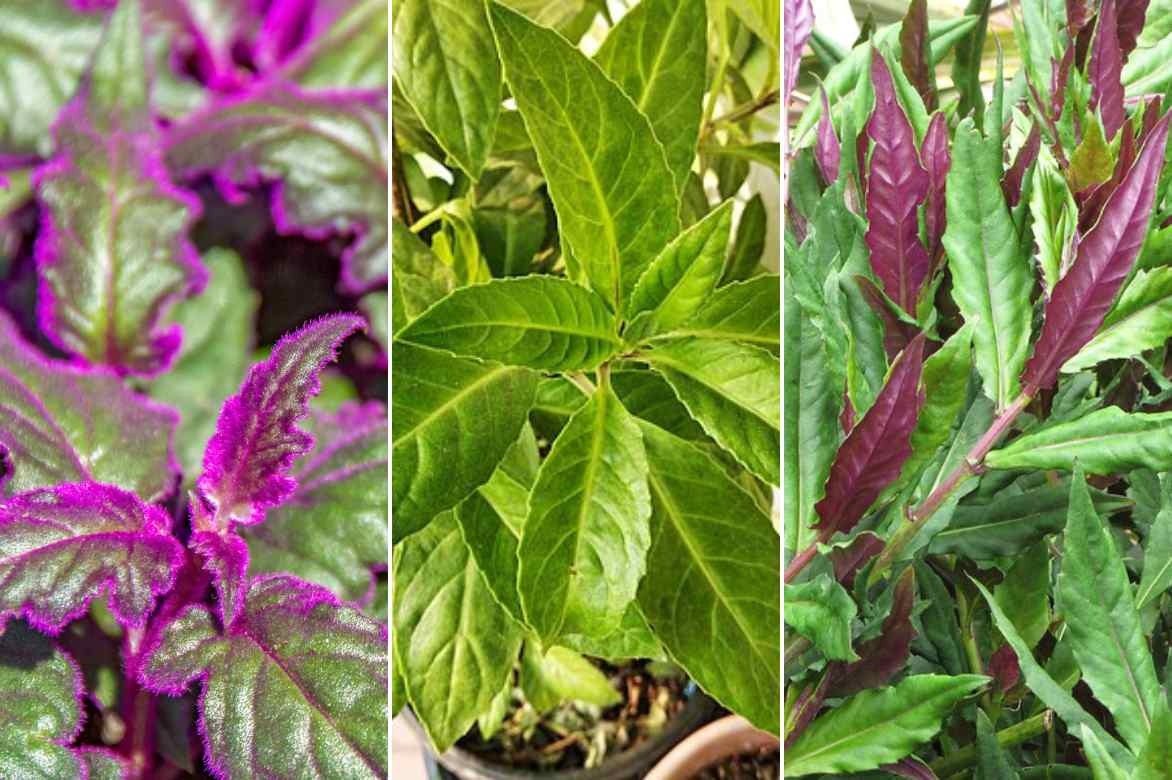
Gynura aurantiaca, Gynura procumbens (© Shahidul Hasan Roman- Wikimedia commons), and Gynura bicolor (© Forest and Kim Starr)
Gynura appears as an herbaceous or semi-succulent plant, with a variable habit depending on the species, which can be upright, creeping, or trailing. The stems, fleshy and slightly angular, are covered with a fine fuzz, characteristic of the genus, and take on a green to purplish hue with age or under the influence of light exposure. Under optimal indoor growing conditions, the plant can reach between 30 and 80 centimetres in height, although older specimens or those grown in hanging baskets develop longer, trailing stems.
The foliage is the main aesthetic asset of Gynura. The leaves, alternate and simple, have an oval to elliptical shape, sometimes slightly dentate at the edges, and can measure up to 15 centimetres in length. Their surface is covered with fine silky hairs, responsible for the plant’s velvety appearance. In the most popular species, such as Gynura aurantiaca, these hairs adopt a particularly intense purple to violet hue, contrasting with the dark green of the lamina. The density and vibrancy of the colours strongly depend on the light received.
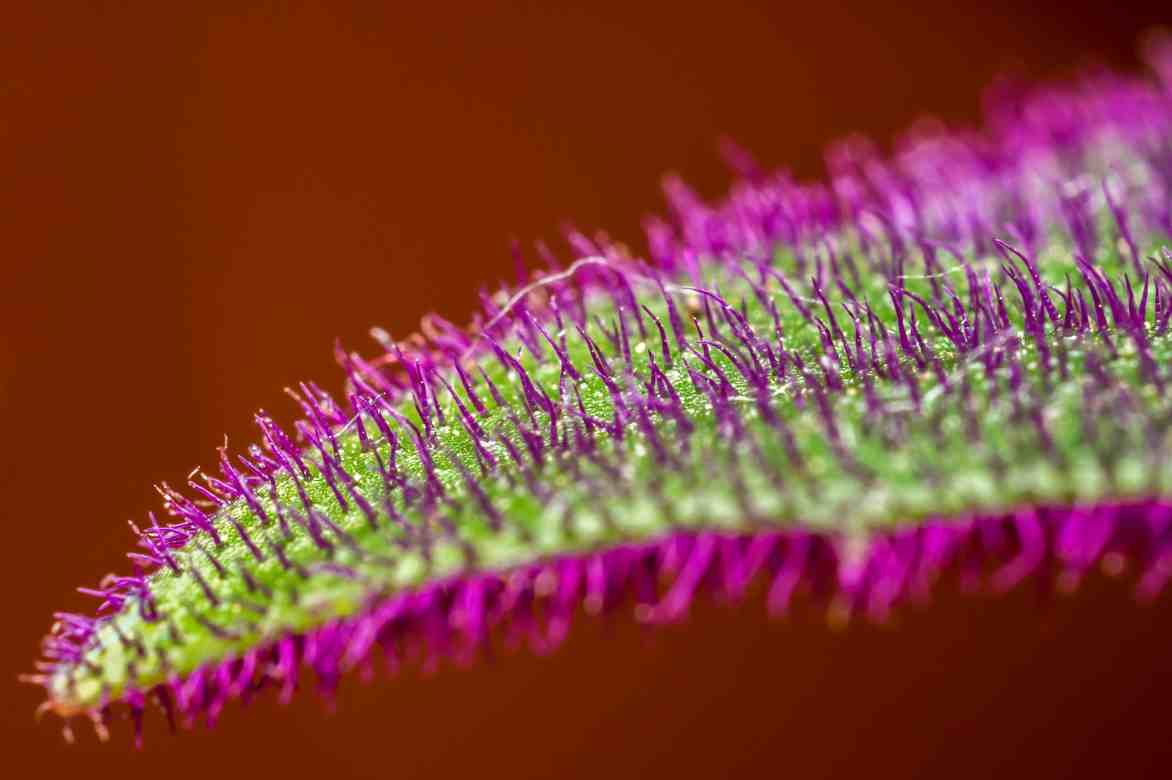
Up close, the plant reveals small hairs on its foliage
Flowering indoors is relatively rare and strongly depends on growing conditions. It generally occurs in late winter or spring, provided stable growing conditions are maintained. The flowers develop in small heads, typical of the Asteraceae, borne at the tips of the stems or branches. Their colour ranges from orange-yellow to bright yellow, and their appearance resembles that of dandelion flowers, with tubular and fine ligules. The term aurantiaca, which means orange in Latin, refers to the colour of its flowers, hence the nickname “Orange Gynura.” These flowers sometimes emit a slight unpleasant odour, which is why some gardeners prefer to remove them to promote vegetative vigor.
Under good conditions, the plant can produce fruits in the form of achenes with fluffy egret-like structures that facilitate wind dispersal in natural environments, although this fruiting remains rare indoors.
The benefits of Gynura procumbens are recognised in Asia. Used in infusions or traditional preparations, this species is reputed for its anti-inflammatory effects and its potential role in regulating blood sugar levels, earning it the nickname “miracle plant” in some local cultures.
Gynura aurantiaca is not classified among highly toxic plants, but ingestion is still discouraged, especially for pets like cats and dogs.
Our varieties of Gynura
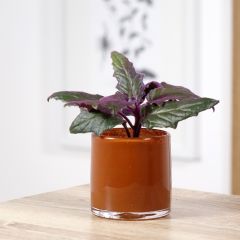
Gynura aurantiaca - Purple velvet plant
- Flowering time February, March
- Height at maturity 45 cm
Pot planting
Gynura is grown exclusively in pots in our latitudes, as it cannot withstand cold and must be protected from temperatures below 10 °C. Growing it indoors allows you to enjoy its ornamental foliage all year round, provided you meet its needs for substrate, light, and drainage. However, it can be temporarily outside in summer, as long as it is placed in a sheltered spot away from direct sunlight, wind, and heavy rain. This summer exposure often allows it to thicken its foliage and enhance its colours, provided it is brought back indoors at the end of the warm season.
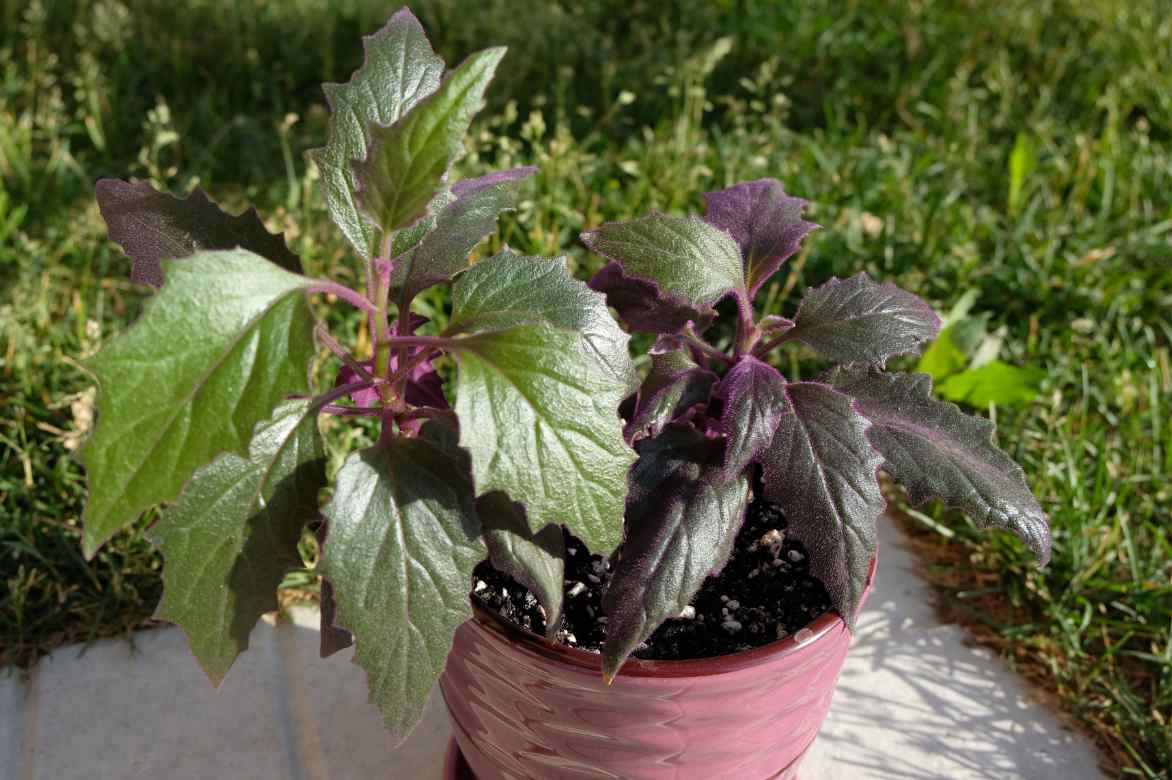
In summer, very temporarily, Gynura can join the terrace
When to plant Gynura in a pot?
Gynura plug plants can be planted all year round, as long as the cultivation is done indoors, in a bright and temperate environment.
What substrate to choose?
Gynura prefers a light, well-draining substrate that retains moisture without excess stagnant water. It is perfectly possible to use a special potting mix for green plants or houseplants. You can also prepare a balanced “homemade” substrate. The ideal composition is as follows:
- 50% universal potting mix or potting mix for green plants, rich in organic matter.
- 30% perlite or horticultural sand, to ensure good drainage and prevent substrate compaction.
- 20% leaf mould or well-rotted compost, to provide flexibility and nutrients.
A small amount of coconut fibres can be added to improve structure and water retention.
Where to place the pot?
Gynura needs a lot of light to fully express its purple hues. It should be placed near a very bright window, without direct sunlight during the hottest hours, as this could scorch the leaves. East or west exposures are ideal. In winter, it can tolerate more direct sunlight.
What pot to choose?
It is advisable to quickly repot our plug plants into a suitable container to encourage their development. It is recommended to use a pot with a diameter of 8 to 10 cm, with drainage holes at the bottom to ensure good drainage. This small volume allows the plug to root well without excess space, which limits the risk of rot due to overly moist substrate. As it grows, Gynura can be repotted into a larger pot. Trailing varieties, such as Gynura sarmentosa, are well-suited for hanging culture, in pots of varying diameters according to the root volume, but always with an effective water drainage system.
And in a terrarium?
Gynura can be grown in a terrarium, but under certain conditions. It is better suited to open terrariums than to a closed and very humid terrarium, as excess moisture on its velvety foliage promotes diseases.
How to plant Gynura?
Here are the steps to follow:
- Place a layer of clay balls or gravel at the bottom of the pot to ensure optimal drainage.
- Partially fill the pot with the previously mixed substrate.
- Gently remove the young Gynura plant from its pot.
- Place the plug in the centre of the pot, ensuring not to bury the collar.
- Fill in with substrate around the plug, lightly compacting without over-compressing.
- Water moderately to moisten the substrate without excess.
Cultivation and maintenance
Light
Gynura requires bright, indirect light to maintain dense, colourful foliage. Too much direct sunlight, especially during the hottest hours, can cause leaf burn. Conversely, a lack of light leads to discoloration and excessive elongation of the stems. Place it near a window facing east or west, or behind a sheer curtain.
Temperature
This plant enjoys a temperate environment, ideally between 15 and 24 °C. It is sensitive to sudden temperature changes and should never be exposed to less than 10 °C. Avoid cold drafts and locations near dry heat sources, such as radiators.
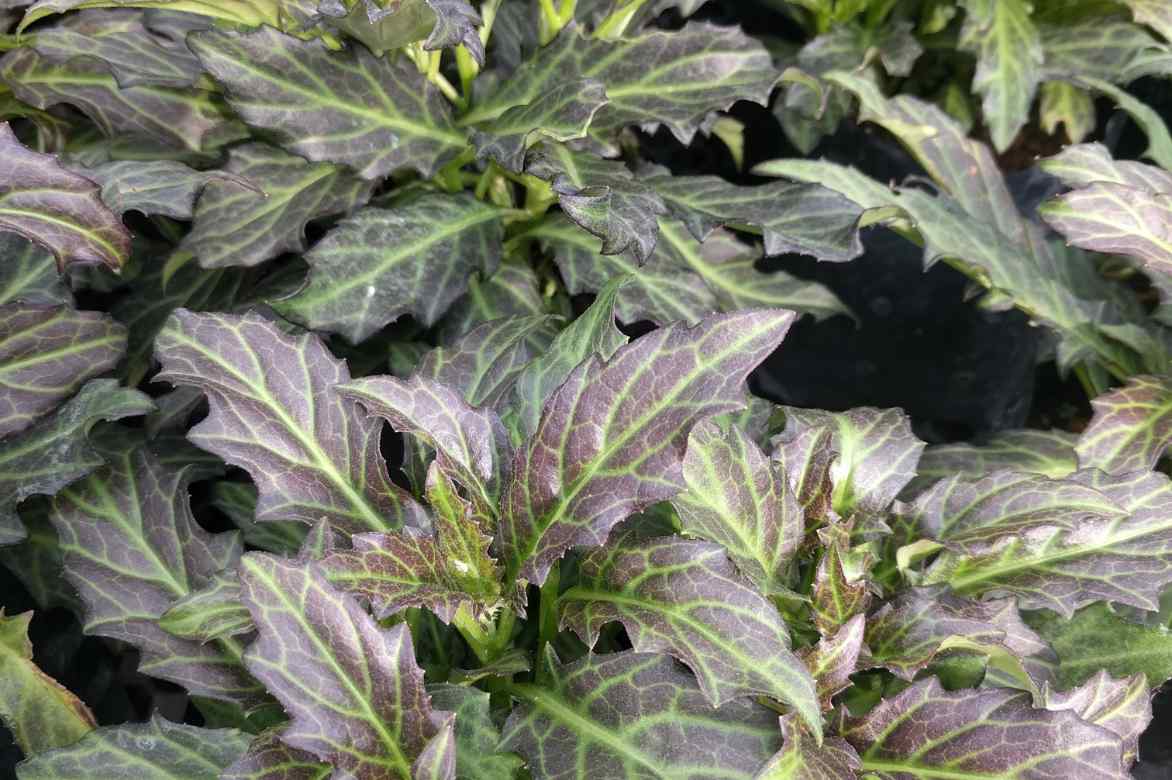
Gynura pseudochina
Watering
Watering should be moderate and controlled. It is advisable to let the surface of the substrate dry to about 2 cm deep before watering again. Overwatering is one of the main causes of plant decline, particularly due to root rot. During the active growth period (spring-summer), watering can be more frequent, approximately once a week depending on ambient conditions. In winter, water needs decrease; watering every two weeks may suffice, always depending on the drying of the substrate.
Humidity
Gynura thrives in a slightly humid atmosphere, with humidity levels between 50 and 70 %. If the air is too dry, especially in winter, place a tray of water with pebbles under the pot or use a humidifier nearby.
Spraying:
It is not recommended to spray the foliage directly. The velvety hairs of Gynura retain moisture, which encourages the appearance of spots and can lead to fungal diseases.
Fertilisation
A supply of liquid fertiliser for green plants, diluted to half strength, every 3 to 4 weeks from spring to summer is sufficient. Excess fertiliser should be avoided, as it can affect the quality of the foliage.
Maintaining the habit
To keep Gynura compact and encourage branching, it is recommended to pinch the tips of the stems regularly, especially for young plants or after flowering. This simple action helps to thicken the foliage, limit excessive elongation, and maintain a harmonious habit, particularly in trailing varieties. Also, remove the orange flowers as soon as they appear, as they emit an unpleasant odour.
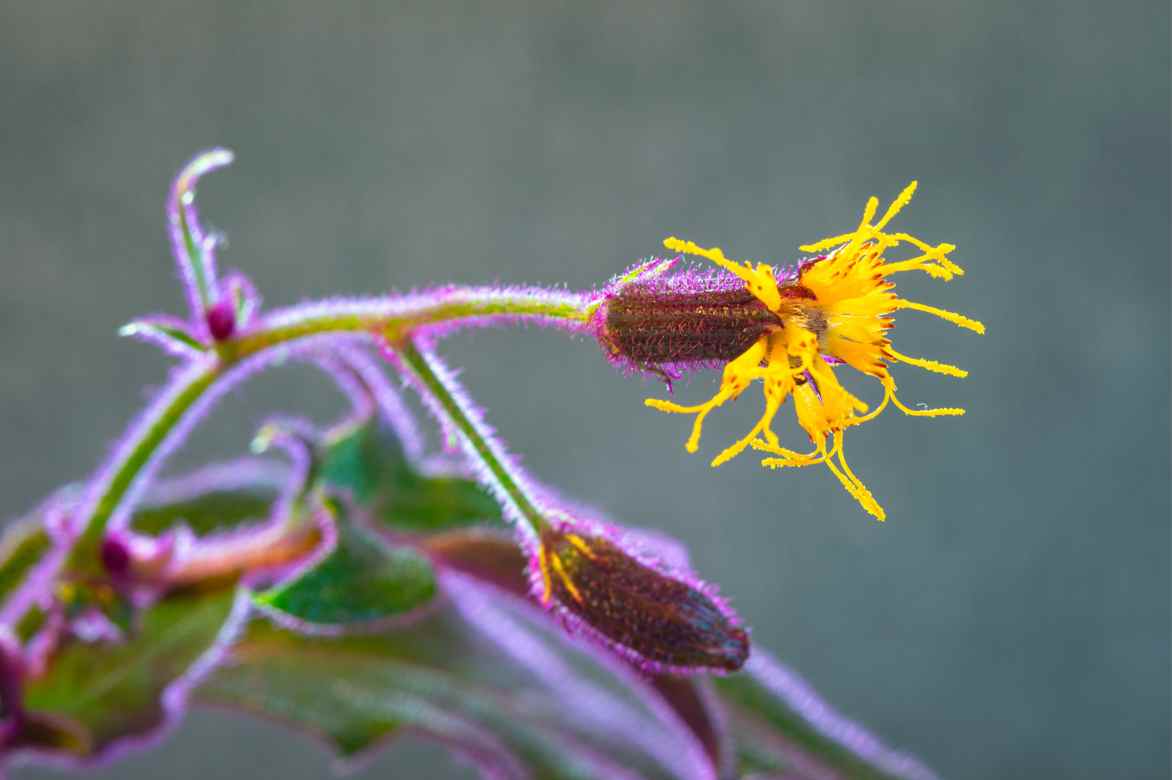
Remove the wilted flowers of Gynura, which smell bad
Repotting Gynura
Repotting should preferably be done in spring, when the plant enters its growth period. It is also possible to repot in summer if the plant shows signs of exhaustion or if the roots have filled the pot.
Repotting is recommended every 12 to 18 months, or as soon as the roots occupy the entire pot. Choose a slightly larger container, always ensuring good drainage. After repotting, moderate watering is sufficient. The plant quickly resumes growth in its new container.
Diseases and pests of Gynura
Indoors, Gynura is less prone to diseases if grown in a well-ventilated environment, without excess water and with a good humidity balance. Here are its main enemies.
| Problem | Observed Symptoms | Recommended Natural Treatment |
| Aphids | Small green or black insects on young shoots, leaf deformation | Spraying with soapy water (diluted black soap) |
| Red spiders | Fine webs under the leaves, discoloured or dull foliage | Indirect misting of air, rinsing with clear water, black soap |
| Whiteflies | White insects that fly away at the slightest movement, sticky leaves | Yellow traps, spraying with black soap or garlic decoction |
| Root rot | Yellowing of foliage, weakened plant, constantly moist soil | Reduce watering, repot in a draining substrate |
| Fungal spots | Appearance of brown or black spots on leaves | Remove affected leaves, ventilate the room, avoid stagnant moisture |
How to take a cutting of Gynura?
Gynura propagates very easily by propagation by cuttings around May, an ideal method to obtain new plants from a healthy stem. Two techniques are possible: cutting in water or directly in soil. Both of these simple and quick methods yield good results.
Cutting in water
- Take a healthy stem of 10 to 15 cm, bearing a few leaves.
- Remove the lower leaves to expose the part that will be submerged.
- Place the stem in a glass of water, changing the water every 2 to 3 days.
- After 2 to 3 weeks, roots will appear.
- Replant the cutting in a pot with well-draining substrate as soon as the roots measure a few centimetres.
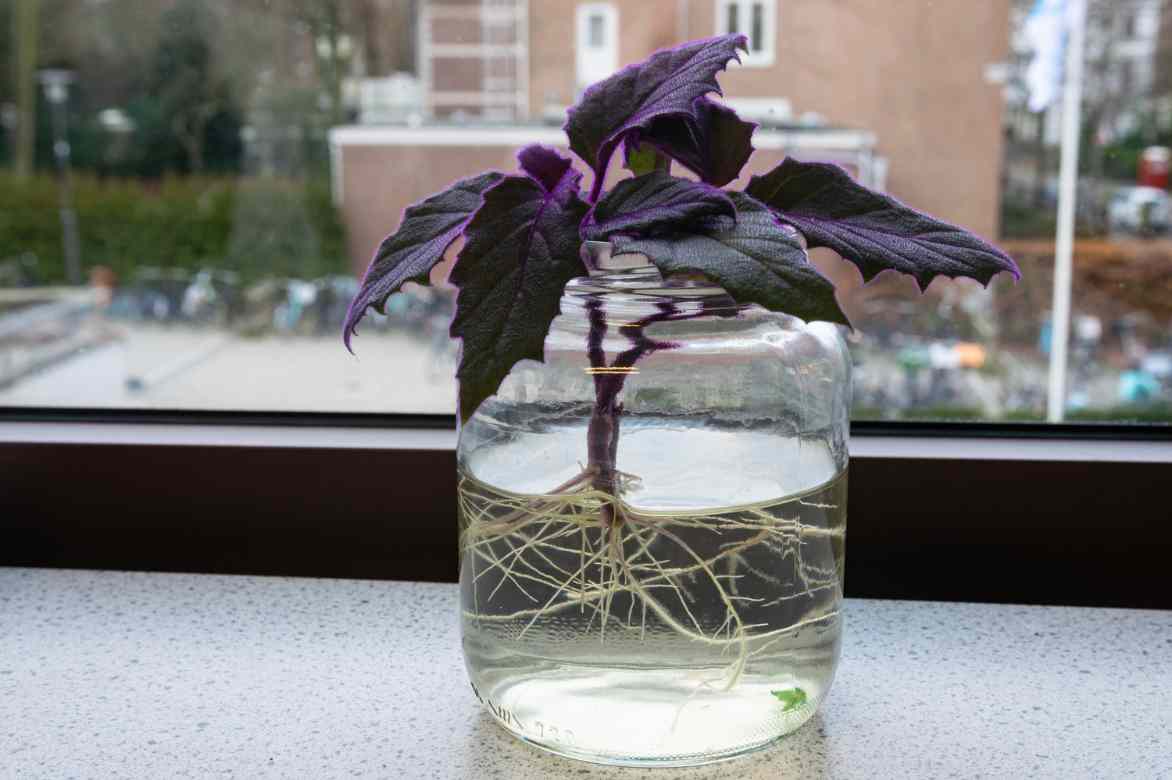
Cutting directly in soil
This technique reduces the stress of transplanting:
- Prepare a pot with a light and well-draining substrate (potting soil + perlite or sand).
- Take a stem of 10 to 15 cm and remove the lower leaves.
- Plant the cutting directly in the substrate, keeping the soil slightly moist.
- Place the pot in indirect light, under a temperature between 18 and 24 °C.
- Root development occurs in 2 to 3 weeks.
Ideas for combinations and decor
With its velvet foliage reflecting purple hues, Gynura captures the eye and instantly adds character to your interior. To showcase it, place it in a hanging pot or on a high shelf, so that its trailing stems create a true cascade of colour. It will thrive in a bright living room, a well-lit bedroom, or even in a slightly shaded corner of a veranda, provided it is protected from direct sunlight.
Gynura pairs very well with plants that have contrasting foliage, such as the Pilea peperomioides, with its round and graphic leaves, or the Chlorophytum Variegatum, which brings light with its variegated foliage. These combinations create a lively and dynamic plant atmosphere, perfect for warming up a room with a bohemian, contemporary, or more eclectic style.
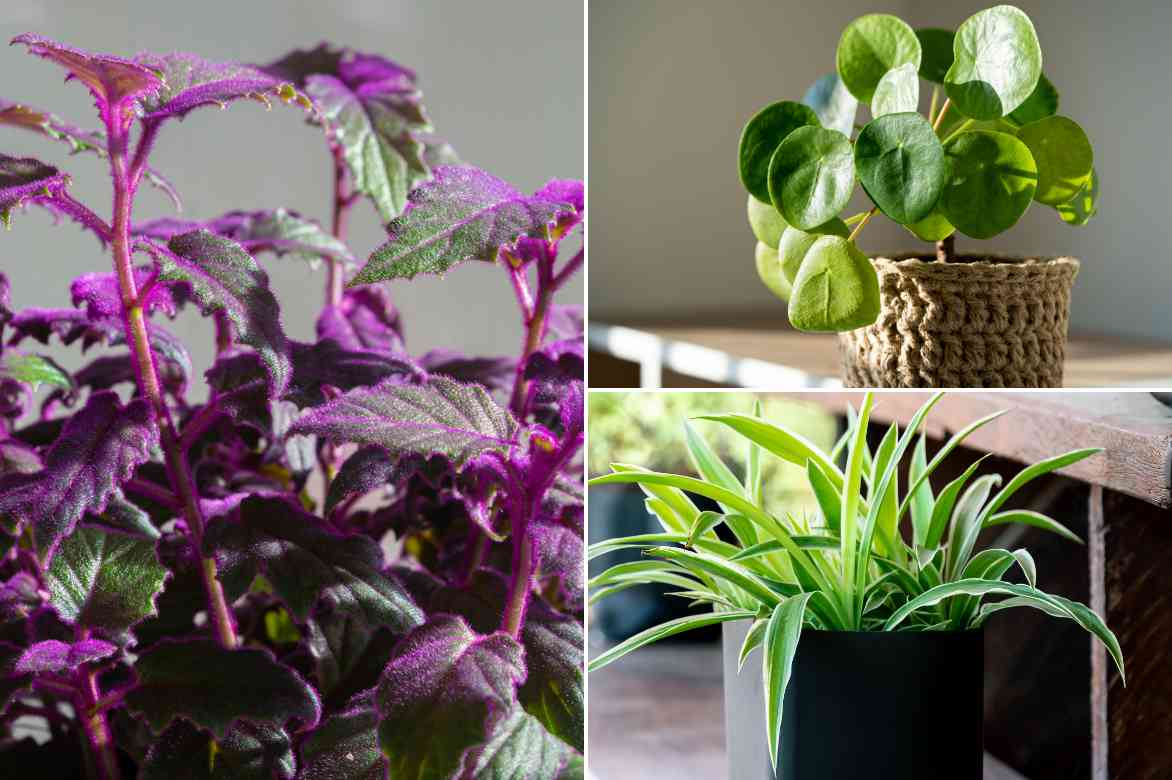
See also
→Discover our wide range of indoor plants.
→Our decorative foliage indoor plants and our flowering indoor plants.
→Many books on indoor plants.
Frequently asked questions
-
Is Gynura toxic to cats?
Yes, Gynura is considered potentially toxic to cats, particularly if ingested. It can cause mild digestive disturbances such as vomiting or diarrhoea. It's best to keep it out of reach of curious animals.
-
What are the benefits of Gynura aurantiaca?
Gynura aurantiaca is not known for its specific medicinal properties. It is other species of the genus, such as Gynura procumbens, that are used in Asia for their benefits, particularly against inflammation or to regulate blood sugar levels. Gynura aurantiaca, on the other hand, is primarily an ornamental plant.
- Subscribe!
- Contents
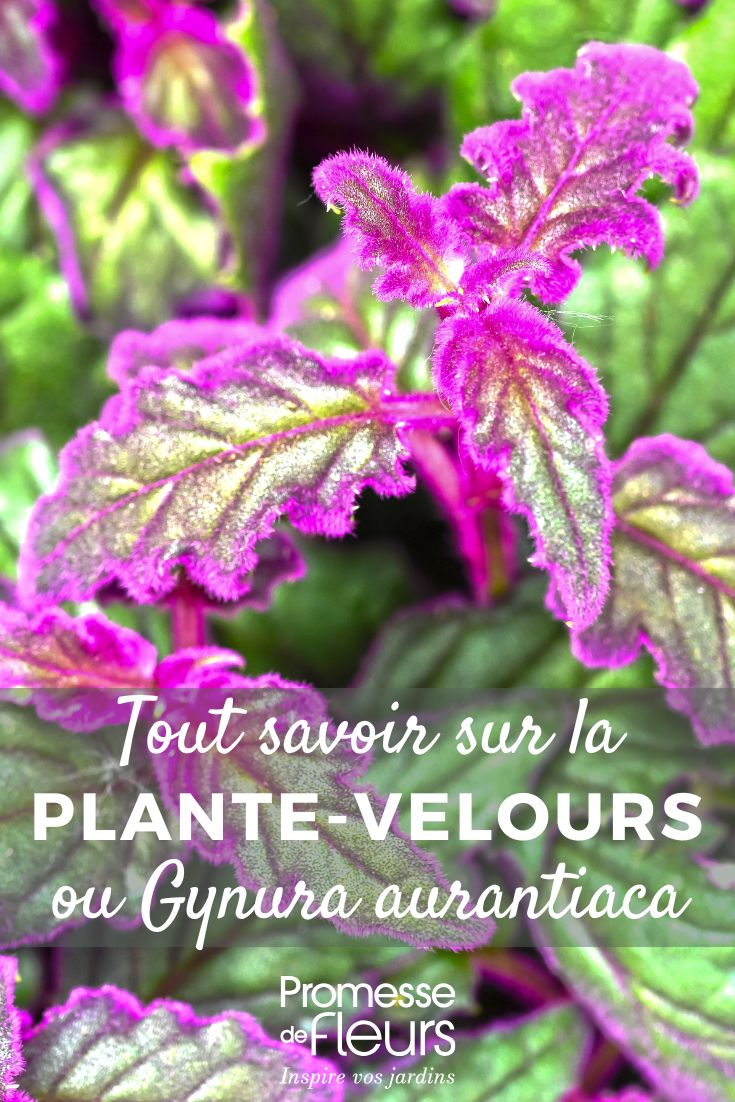































Comments